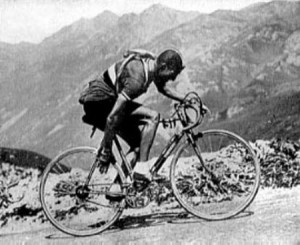FEATURES Bartali, a Champion of Values
Champion on his bicycle, champion of values in his entire life, in September 2013 Gino Bartali has reached the highest honor given by the State of Israel getting into the Righteous Among the Nations on the wall of Yad Vashem Memorial. The great Florentine cyclist, among the most beloved Italians of all the times, has been recognized with reason for his role in the network Delasem helping Jews persecuted by Nazi-fascism and at the same time as the personal savior of a family hidden in one of his apartments in Florence.
This last aspect of his heroism that was unknown until few years ago and that has reached the general public after Giorgio Goldenberg – in December 2010 – released a brand new testimony to Pagine Ebraiche, then re-launched with great effect by the Italian press as well as by the international one. Eleven years old in 1943-1944, Goldenberg was hidden along with his loved ones (his parents and his sister Tea) in a house in Via del Bandino, a suburb on the outskirts of the historic center. His family came from Fiume – Italy at that time, now Croatia – and knew Bartali since the Thirties. That was the beginning of an intense friendship, marked by many happy and meaningful moments. Until autumn 1943: in the most difficult months for European Jews Gino, (known in Italy even as “Ginettaccio”) demonstrated the depth of that relationship, preventing his friends from getting arrested by persecutors and deported to the death camps.
“Bartali was a devout Catholic. Archbishop Elia Angelo Dalla Costa (recognized as Righteous Among the Nations in 2012) had married his parents and maintained a close relationship to his father. Consequently, following the German occupation of Italy in September 1943 Bartali, who was a courier for the resistance – Yad Vashem’s website reports – came to play an important role in the rescue of Jews within the framework of the network initiated by Dalla Costa and Rabbi Nathan Cassuto. Bartali, who was known to cover large distances with his bicycle for training purposes, transferred forged documents that were hidden in the handlebar and seat of his bicycle from one place to another. His activity spanned over a wide area. He also distributed forged documents that were produced by the Assisi network, another rescue operation initiated by Church people in that town. When Bartali was stopped and searched, he specifically asked that his bicycle not be touched since the different parts were very carefully calibrated to achieve maximum speed”.
Goldenberg’s remembrance, a brand new chapter, came out after the appeal launched in 2010 by the Italian Jewry newspaper to search new evidence of the bravery demonstrated by Bartali, silent hero who never talked about his merits except to his closest relatives. The initiative allowed to compose new pieces of a mosaic full of suggestions and contributed in a decisive way to the solemn recognition of Yad Vashem.
“The cellar where we lived – Giorgio told Pagine Ebraiche – was very small. A door opened to a courtyard but I could not get out because of the risk of being seen. We slept, the four of us, in a bed: me, my father, my mother and my sister Tea. I don’t remember where my parents grab the food. I just remember that my father always remained in the basement while my mother went out with two buckets to fetch water”.
To delve into the Goldenberg affair is also a recent book of Canadian brothers Andres and Aili Mc Connon, Road to Valor, published in Italy by 66thand2nd under the title “La strada del coraggio” . Memories, bravery, deepest values. But also victories that have brought prestige to Italy. The brothers McConnon delve into the many aspects of a complex character such Bartali and report his main achievements including Giro d’Italia (three victories: 1936, 1937 and 1946) and Tour de France (two victories: 1938, 1948). In the background, the eternal dualism with Fausto Coppi which divided the country.
“I think we were conscious from the beginning – Aili explained in a recent interview – that we really did want to make it a story that would feel exciting like a novel but where everything was historically backed up and non-fiction, and to make it as readable as possible. Our goal was to teach a lot of people about a history they might not have been discovered. We realized we wanted to pitch Bartali as not just a two-dimensional character but really sort of understand all the aspects of his character.”
Full of interest even the pages that describe the last years of Gino, when his hidden secrets began to being known by a growing number of people. “In the last years of his life – brothers Mc Connon wrote – Gino began to suffer for his health. The heart which had supported him to ride in a lifetime the staggering distance of nearly 600,000 miles became more capricious, so that he needed a pacemaker. His voice, undermined by a throat operation and by decades of cigarettes, had become hoarse and almost incomprehensible. The complexion had become yellowish, his hair started disappearing. He became day by day heavier and slower. Aware that his time had come, became gradually more thoughtfully. The interviews of last years show a man at peace with himself”.

